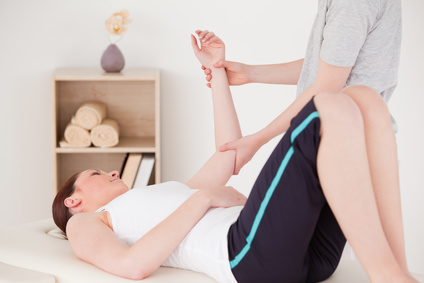Care of the arm until an appointment with a physical therapist can be made is simple. Don't try to power through a task or continue to play if the symptoms of tennis elbow are present. It can exacerbate the condition and result in more damage.
The affected arm should be rested and ice treatments applied every 10-20 minutes. It's also helpful to support the injured arm and elbow by wrapping it with an elastic bandage to relieve pressure on the muscles and tendons.
Physical therapy for tennis elbow is beneficial for:
- Relieving pain
- Reducing inflammation and swelling
- Strengthening muscles and tendons
- Reducing the risk of re-injury
- Rehabilitation if surgery is required
Tendons heal slowly and left untreated, the condition can take weeks or even months to heal and if the injury is severe enough, recovery can take up to a year. The condition can become chronic, with periodic flare-ups upon usage, accompanied by inflammation and swelling.
It's important that individuals use equipment that's appropriate to their size, strength and fitness level when participating in sports. People begin to lose strength in their forearms as they age that increases the potential for injury, while others over-estimate their fitness level.
People who have weak forearm muscles are at increased risk of tennis elbow, along with those who are performing unfamiliar tasks, doing something they seldom do such as hammering, or learning a new skill like knitting.
Back In The Swing: Physical Therapy and Tennis Elbow

Tennis elbow is one of the most common injuries that people sustain, but it doesn't just happen to tennis players. Less than 5 percent of all tennis elbow injuries occur in people who don't play tennis at all.
The term tennis elbow is often used to describe any injury that occurs as a result of someone using their elbow, wrist or hand in repetitive motions as part of their job, hobby or sports activities. Since the muscles and tendons in the hand, wrist, arm and forearm are interconnected with the elbow, a case of tennis elbow doesn't even have to be the result of flexing the elbow.
From office workers and mechanics to musicians, anyone who performs the same type of motions over and over can experience the intense pain of tennis elbow. Men are more likely to develop the condition than women and it typically flares up in their 30s to 50s. Even children can develop tennis elbow.
The condition can be the result of actions over time or it can happen suddenly when an individual performs a forceful action that includes a pulling, swinging, lifting or twisting motion. Someone who has developed tennis elbow will have pain that can be more intense in the elbow or wrist and have difficulty grasping and holding objects.
Even holding a cup of coffee, gripping a fork to eat, or opening a door can result in intense pain. There will also be a lack of strength in the hand, wrist or forearm. It's essential to have tennis elbow properly diagnosed to determine the extent of the damage.
PT for Tennis Elbow

Resting the arm is essential until your physical therapist says it's time to begin therapy. He/she will develop a plan of specialized exercises that help you maintain flexibility, range of motion, and strengthen tendons and muscles. Splints and counterforce braces may be used for stabilization and to distribute pressure throughout the area instead of just on the tendons.
During the healing process, your physical therapist may incorporate a variety of treatments depending upon the extent and severity of the injury. Dry needling, acupuncture and therapeutic massage may all be utilized to ease pain. The therapies are also beneficial for stimulating your immune system and improving circulation to the affected area that can help speed healing.
Ultrasound therapy and electrical nerve stimulation known as TENS therapy are other options that may be employed for your healing and pain relief. Dietary supplements may be recommended to ensure your body has the proper nutrients for the quickest healing.
Your physical therapist will teach you how to stretch your arm and warm up properly before engaging in activities. Ergonomic assessments and recommendations are available for ways to perform work and home tasks easier and more efficiently while you heal and to prevent re-injury.
In the most severe cases, surgery may be needed to mend a tear in the muscles or tendons. The same techniques for treating a milder case of tennis elbow are equally effective for rehabilitation following a surgical repair.
Tennis elbow is a painful condition and your physical therapist has a variety of therapies that will help you heal, improve conditioning, and aid in reducing the risk of re-injuring the arm in the future. With the care of your physical therapist, you'll heal quickly and prevent the injury from becoming a chronic condition.

